November 5th, 2011
| 2 Comments »
It’s November again. And this morning when I arose, in the dark still silence, to the hum of the furnace and an noisy, eager cat face, the air smelled definitively of the impending winter. Never mind that it might reach near 60 today, or that the sun burns bright in that kind of blue sky that hurts your eyes, the wind that touched my face when I let out our early riser told me ‘You know, I could snow at any minute.’
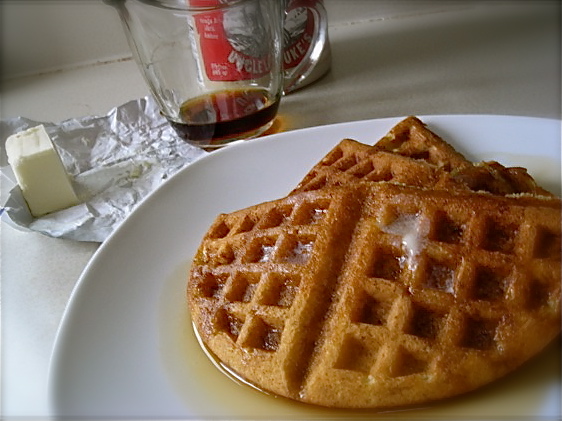
We’re pretty fortunate that our Fall has been both spectacular and snowless. The only month without recorded snowfall in Minnesota is July, and with the frost that came so early in September, I felt certain that a drifting white mass would come sooner or later. I’ve been happy to be so, so wrong.
These Cornmeal Waffles are a favorite cold weather breakfast. First crafted and enjoyed on a crackling, numbingly cold day in January of 2010, they’ve gained a permanent foothold in my breakfast rotation, the waffle recipe I turn to time and again. With their crisp edges, and the sharp tang of buttermilk contrasting with the deep, rich maple syrup, it’s a dance of flavors to awaken you and set you upright, not to mention bolstering you against cold and wind.
The inevitable Winter is just around the corner. Shore up your weekends with foods that bring warmth to your home and fuel for the internal furnace. These waffles freeze beautifully. I always make a double, or even a triple batch so that we have lots of extras on hand.
Do you have a preference for Waffles or Pancakes??
Buttermilk Cornmeal Waffles
1 cup sifted all-purpose flour (sift before measuring)
1 cup yellow cornmeal, preferably stoneground
2 teaspoons baking powder
1 teaspoon baking soda
1/4 teaspoon salt
3 large eggs
2 cups well-shaken buttermilk
6 tablespoons vegetable oil plus additional oil for brushing waffle iron
Into a large bowl sift together flour, cornmeal, baking powder, baking soda, and salt. Repeat sifting 2 more times.
In another large bowl whisk together eggs, buttermilk, and oil. Add flour mixture all at once and whisk just until combined.
Preheat a waffle iron and preheat oven to 200 °F.
Brush waffle iron lightly with additional oil. Spoon batter into waffle iron, using 1/4 cup batter for each 4-inch-square standard waffle and spreading batter evenly, and cook according to manufacturer’s instructions. Transfer waffle to a baking sheet and keep warm, uncovered, in middle of oven. Make more waffles with remaining batter in same manner, brushing waffle iron with more oil before adding each batch.
Serve waffles with syrup.
(from Kristin at The Kitchen Sink Recipes, slightly adapted from Gourmet magazine)
What’s on YOUR plate this month??
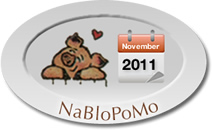
July 16th, 2011
| 7 Comments »
People, I’ve madly fallen in love with radishes.
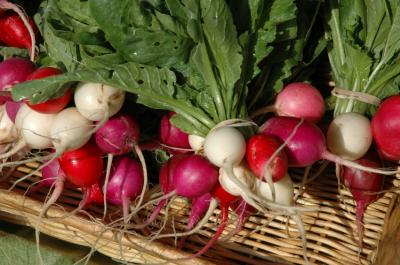 (photo courtesy of Really Natural) (photo courtesy of Really Natural)
I do remember not particularly liking them as a kid. But then again, I didn’t care for much then anyway, being raised on a typically 1970’s diet, I was your typically picky little thing. Fresh foods weren’t that present in our home so my exposure was lacking and my palate not particularly advanced; it’s no shock I wasn’t at all enamored with the radish’s peppery bite, a sting to the tongue that I found unpleasant. My sister Karen loved them, dragging them through a plate of table salt before popping them in her mouth. Even that typical dressing did nothing to take the edge off the flavor. So for the most part, I’d ignored them.
Then something happened a few years back. On a trip to the Farmers Market, I spied a large bunch of red, white and pink radishes- it was an enormous amount- and was only a dollar. I picked them up, passed a buck to the farmer and placed them in my bag. Once home, I stared at them and thought ‘Great. Now what?’ I ate one, and it was divine. Fresh, snappy, crisp and tart, but not harsh and sour like I recalled. Still, I didn’t leap headfirst into devouring them. I remained rather skeptical. And they languished in my fridge until I was forced to do something, anything, with them.
So I pickled them. On a whim. And went tuckus over teakettle for the crisp little discs, eating them on sandwiches, with my fingers and finally with a fork to grab the last little slices from the dredges of their vinegary brine. And it was soon after that when I first dragged a cold fresh radish through a slab of creamy butter to discover one of the best, and most surprising treats I’ve ever tasted. My eyes were now opened to the radish. Once again. Adulthood is a wonder around every corner, especially when discovering the foods from your childhood that once caused you to turn up your nose are now part of your regular gustatory delight.
So they’ve happily made a comeback; the inexpensive little things can be had sometimes on a 2-fer deal with any farmer willing to move their bounty. I scrub them down and place them in a baggie where they happily keep for days on end, willing that they last that long in my fridge. I eat them for breakfast a lot, sliced thick on good toasted bread with slices of butter, or most recently, this delicious sandwich creation that I’m thoroughly ga-ga over.

A cooked egg, nice and firm is placed a top a bed of greens on nicely toasted bread, and covered with several shredded radishes. The key is to shred the radish directly over the egg. Something about the fresh spray of liquid released makes for a much better flavor. I like spinach with this, but I’ve used spring greens, garden lettuce and romaine as well. This is a summery breakfast, if I’ve ever dreamed of one.
I took my radish love one step further too, recently, when I roasted an entire batch of them.

Roasting radishes takes the sharp flavor away, and replaces it with a mellow soft rendition that is palatable to anyone, even the most avowed radish hater. One would hope, anyway. I could have eaten these like candy, but instead, I caramelized a big pan of vidalia onions and made the two of them into a delicious tart atop a flaky puff pastry crust.
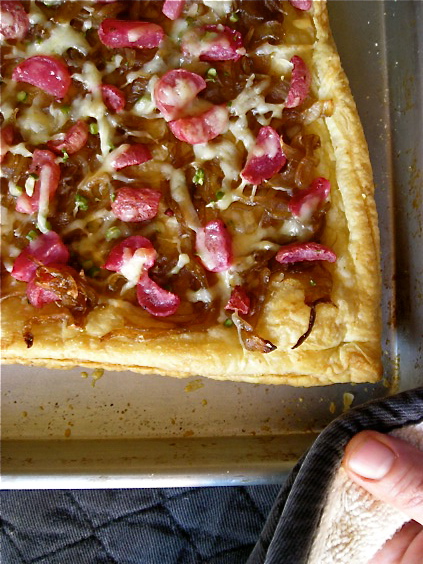 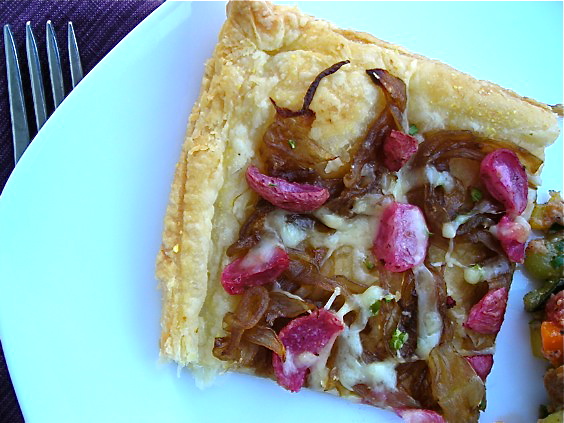
This was a sweet, tender and amazing hand held meal, soft like summer nights, fresh as the season and when topped with just a little Gouda cheese, a bit of savory tang that balanced the vegetables perfectly. Eating a slice of it, on my patio, with a lovely glass of Rosé wine and a perfect summer night surrounding me, I felt a million miles away from my life, but in the simplest way possible. I love how a good meal, with gentle ease can transform an ordinary day into something surreal and dreamy. That’s the magic in a plate of really, really good food.
So…. do you like radishes? What do you like to do with them?
Roasted Radish & Caramelize Onion Tart
Scrub one bunch of radishes well, removing tops and roots. Cut into halves or quarters and toss with a bit of seasoned oil of choice. Roast at 400° until tender. It won’t take too long, maybe 10 minutes.
Slice two Vidalia onions and place in a hot skillet. Cook onions over medium heat, turning frequently, until browned and tender, about 15 minutes. Reduce heat to low, add a few tablespoons of brown sugar (or a drizzle of good honey) a tablespoon of kosher salt and a dash or two of balsamic vinegar. This is my favorite way to caramelize onions, but you may have your own method. Continue cooking the onions for about 20-30 more minutes, or until they are very soft and richly browned. Stir them on occasion, and be careful not to let them burn.
Thaw one sheet of puff pastry. Roll out sheet to desired thickness on parchment paper, then transfer to baking sheet. Poke holes in pastry with a fork and place in 400° oven, baking until lightly browned, about 10-15 minutes. Remove from oven, spread caramelized onion over the crust then top with roasted radish and a small amount of a good sharp aged cheese of your choice. I used Gouda because I had a some on hand. Fontina and Gruyere would be good options too. Place back in oven and bake for about 15 more minutes, until edges of pastry are crisp and brown and toppings are hot. Allow to cool slightly, then serve. Can also be served at room temperature.
April 27th, 2011
| Comments Off on Kellogg’s Virtual Breakfast Chat
Remember when I mentioned last week that I was participating in a virtual breakfast through The Motherhood with some other wonderful bloggers? The chat occurred this past Wednesday, when I was right about to be plunged over the cliff into complete sickness. I managed to deal with the chat perfectly, then set my computer aside and just about collapsed. The rest of that day I was immobile from fever, wandering in and out of sleep, twisting in fevered dreams.
Oy…..

But I survived. The chat was quite fun. It was video and text chatting, with two nutritionists from Kellogg’s, so you can bet it was pretty heavily geared towards eating cereal. I personally prefer something a lot more substantial for my first meal of the day. Still, cereal is a pretty standard breakfast for many, especially children. One aspect of the chat was to discuss the most recent dietary guidelines set forth by the Dep’t of Health and Human Services and the USDA. The Dietary Guidelines list four nutrients that American children and adults are not getting enough of: dietary fiber, calcium, vitamin D and potassium, and apparently breakfast cereals are noted specifically in these guidelines for helping people meet their B12, folic acid, iron and Vitamin D requirements. They even spoke about the fact that Fruit Loops and Apple Jacks both have 3 grams of fiber per serving. With information from health studies that points to fiber intake being a shield against the risk of death from cardiovascular disease, infectious and respiratory illness and, for men, certain cancers. Hmmm. At this point, I wanted to ask what the sugar content of these supposedly fiber-rich cereals were but decided to just quietly pass through that part of the discussion. I was a bit surprised to hear some of this information, and along with my caution about sugar levels in breakfast cereal, the main reason I won’t eat many of them at all, I’m still firm on my belief that there are much better breakfasts to start your day with.
Thankfully, my co-hosts agreed. They were filled to overflowing with amazing and delicious breakfast options; waffles and pancakes topped with greek yogurt, and copious amounts of fresh fruit, smoothies with berries and ground flaxseed, parfaits made with yogurt, cereal and nuts. Kids don’t automatically know what constitutes ‘breakfast food’ too, and when my son was younger I told him that I didn’t care what he ate for breakfast; I just wanted him to eat something before school each day. So he would often eat leftovers from dinner, cold pizza or sometimes mac and cheese. On occasion he would eat soup, or make a half a sandwich with turkey or roast beef. The most important thing to me was that he was eating something. After that, it was up to him.
I’ve become much more aware in the last few years of how a good healthy breakfast can make such a huge difference in the rest of your day. And I love exploring the multitudes of options that I can eat each morning, sometimes finding myself getting rather excited about what my morning meal will be! And it’s always good to get excited about your food.
If you’re interested in the newest Dietary Guidelines, the entire document can be downloaded from this link:
http://www.cnpp.usda.gov/DGAs2010-PolicyDocument.htm
If you want a full summary of our virtual breakfast, you can find that information here:
http://www.themotherhood.com/talk/show/id/62187
DISCLAIMER:
I was financially compensated for participating in this chat. All opinions are my own.
March 16th, 2011
| 5 Comments »
Little that’s gone on lately has been ordinary, especially in other parts of the world. I’ve watched a few videos, scanned the headlines and saw a few photos, but for the most part, I’ve stayed far, far away from immersing myself in the news coverage of what’s gone on in Japan. I’m not posting on Facebook about it; I don’t tweet, or retweet about it. And quite frankly, if you want to call me insensitive, go ahead. That’s your right. Just remember that it’s my right too, to decide how I deal with it. And this is how I manage it, because the last time I was soaked in a tragedy, it ended up being stuck with me for the rest of my life.
Back when the world seemed a lot less harsh, I woke on a gorgeous September morning in Las Vegas, ready to spend my day at an International Baking Convention. I was the office manager for a large wholesale bakery in the Cities, and was there to check out new equipment, new software, and new procedures, and I never got the chance. Because that morning was the 11th, in 2001. And we all know what happened then. I watched the entire horror play out on television, right in front of me. I watched bodies plummet through the sky; I watched people on the streets, staring in terror. I watched those towers fall and I cried my eyes out. The country fell apart before my eyes, and I was stranded thousands of miles from home. Everywhere I went for the next six days until I returned home, it was like the tragedy was embedded in my skin, my ears, my eyes. It was all everyone talked about. It was on every television, in every podunk spot that the car stopped as I made my way home, across the gorgeous country amidst the worst times in recent memory. Yes, my boss and I drove home from Nevada; it took 2-1/2 days. We drove through the mountains of the West, through Utah and Colorado and were surrounded by stunning vistas while the sorrow poured out of the radio. A pall had settled on the nation and every gas station, every coffee shop, every tiny diner along the way were full of grim faces and tears. It’s been 10 years since that all happened and I still can see every detail; I can still feel my stomach sinking in agony, like it did that morning while I watched, unable to tear my eyes away. If I catch a glimpse of the clock, and it happens to read 9:11, I can’t get away from the image it leaves with me. And I can’t fill my head, again, with such sorrow.
I’m a sponge; I absorb my surroundings and it gets under my skin to stay with me. And it isn’t just events. It’s people, it’s daily situations, it’s the crabby strangers in passing, the nasty drivers on the road. Negativity can easily fill me up and just as easily take me down. I need to protect myself from drowning in it and so I simply turn away. It’s isn’t that I don’t care. The problem is that I care too much and me, this tiny individual, can’t offer much more than a solitary prayer of compassion. My repetitive tweets won’t do anyone any good; yet another posting on yet another heart-wrenching video won’t do anything. There are plenty of people to spread the news, and I just turn and walk away because to do otherwise would be more images seared in my brain that will stick with me forever. I can’t do that to myself. It’s bad enough that in the darkness I sometimes still see a burning skyscraper, and bodies falling through the smoke. After 10 years you’d think they would fade, but they haven’t. Even the few images of the destruction in Japan won’t replace the shocking pictures of that gorgeous September morning. In fact, they’ve joined them. And that’s not something I need.
So I made pancakes.
 
Because I needed to feel ordinary and plain, to have something of a constant come up during a time that is now written indelibly in the history books. And for me, it was Pancakes. And not just any Pancakes; these were Wheat Crumb Pancakes, made with fresh bread crumbs as the base. It was odd, to say the least, and maybe not exactly what I would reach for to try and raise some ordinary sense to my day, but it worked. Strangely enough.
The recipe came from Marion Cunningham’s The Breakfast Book. I picked this book up at a used book store many years ago, and it languished in my cookbook cupboard for a long time. I glanced at it once or twice, but never really absorbed it, and last year in a book purge, I almost added it to the boxes I was giving away. But something made me leave it on the shelf and I’m so glad I did because what exists in those pages is a treasure trove of simple, hearty, wholesome and flavorful breakfast recipes, and everyone I’ve tried has been delicious. These Wheat Crumb Pancakes were amazing; fluffy and light and so flavorful. I added some texture to them by tossing finely chopped honey-roasted peanuts into the batter, and replacing some of the liquid with pureed mango and peaches. They cook up thick and hearty, and beg for a dousing of maple syrup. A plate of them set my emotions and grounded me, just as I had hoped they would.
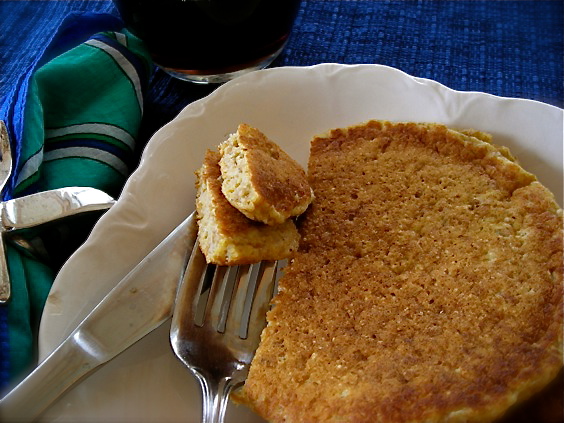
Wheat Crumb Pancakes
1-1/2 c. fresh wheat bread crumbs
1-1/2 c. buttermilk
2 T. butter
1/2 c. whole wheat flour
2 eggs, lightly beaten
2 t. baking powder
1/2 t. salt
Place bread crumbs in a large bowl. Heat milk and butter in small saucepan until butter is melted and milk is hot. Pour over bread crumbs and let stand for 5-10 minutes, stirring to fully combine.
Add flour, eggs, baking powder and salt to bread crumb mix. Fold together until just mixed and let stand for a few minutes. Cook pancakes on stovetop, or an electric skillet. Top with maple syrup and butter, if desired, or toppings of choice.
From ‘The Breakfast Book’ by Marion Cunningham
NOTE: Fresh bread crumbs can be made from several slices of good quality whole wheat bread. Place them in a food processor and process until they’re the size of peas. Do not sub in dried bread crumbs, croutons or Panko. I like to keep a ziploc bag of fresh breads crumbs in the freezer. Any leftover bread gets processed and added to the bag. The crumbs are wonderful to have on hand for many uses in the kitchen.
More Pancake love from Kate’s Kitchen:
Whole Grain Pancakes
Oatmeal Pancakes
Pumpkin Pancakes with Winter Fruit Compote
Whole Wheat Banana Pancakes
Fresh Cherry Syrup
Fresh Blueberry Syrup
March 6th, 2011
| 2 Comments »
Sometimes I come across a recipe by accident, through a bevy of channels found by clicking here, clicking there, following some promising links and then WHAM! you spot something that looks so delicious that you know you have to make it, right there and right now.

Of course, it helps when I have everything on hand to make it, with the bonus of it being a much healthier version of tea bread, which, let’s face it, is just a big oblong cake, isn’t it? Most tea bread recipes could easily be baked in a bundt pan, or as rounds, covered with frosting of any sort and masqueraded as a cake. No one would really know the difference.
But this tea bread, with it’s luscious compote of cooked sweet dried cherries and figs comes out as something else. It’s dense and moist, yes, but it’s much more bread-like than your typical rectangular 9×5 offering. And I’m kind of a sucker for anything with figs in it. Back to my childhood, when a Fig Newton, fresh and cakey filled with thick pureed figs was my most favorite store-bought cookie, to the now of my adult life, and the soft magical collapse of a fresh fig in my mouth, or the sweet bite of a dried one in my morning oatmeal, there really isn’t a time that I’ll pass up noshing on figs. The glorious fig has no fat whatsoever, no saturated fat, and no cholesterol or sodium. They’re loaded with calcium too, a half cup worth of dried figs fills your entire daily requirement for calcium intake. They’re a complex carbohydrate, rich in fiber and loaded with essential minerals like potassium and iron. Excellence all around.
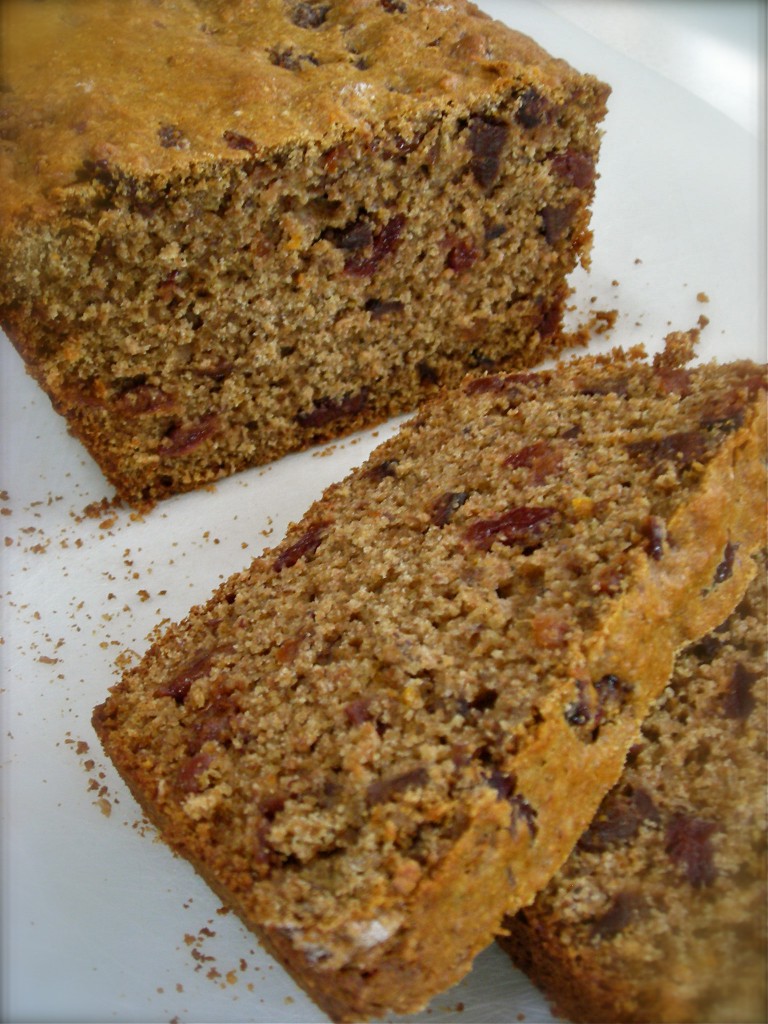
The recipe comes, not surprisingly, from Eating Well magazine, a publication that consistently offers up health, nutrition and simple good taste. You don’t need much in the way of fancy ingredients or advanced cooking skills to make the majority of offerings in the magazines, and along with consistently good recipes, they offer plenty of up to date nutritional information and honest discourse about food trends.
And recipes with figs. Enough said.
Cherry Fig Tea Loaf
1 c. dried tart cherries
1 c. chopped dried figs
1 c. orange juice
2 c. whole wheat flour
1/2 c. honey
1/4 c. wheat bran
2 t. freshly grated orange zest
2 t. baking powder
1 t. baking soda
1/2 t. salt
2 large eggs
2/3 c. plain soy milk
3 T canola oil
1 t. pure vanilla extract
Preheat oven to 350°F. Coat a 9 1/2-by-5 1/2-inch loaf pan with cooking spray.
Combine cherries, figs and orange juice in a medium saucepan. Bring to a simmer over low heat. Simmer, covered, for 5 minutes. Strain, reserving 1/3 cup of the fruit-cooking liquid. Set the fruit and liquid aside in separate bowls.
Stir together flour, sugar, wheat bran, orange zest, baking powder, baking soda and salt in a large bowl. Whisk together eggs, buttermilk, oil, vanilla and the reserved 1/3 cup fruit-cooking liquid in another large bowl. Add to the flour mixture and stir with a rubber spatula until just combined. Fold in the reserved fruit. Turn the batter into the prepared pan.
Bake until the top is golden and a cake tester inserted in the center of the loaf comes out clean, 35 to 45 minutes. Let cool in the pan on a rack for 10 minutes. Loosen edges and invert the loaf onto a rack to cool. Serve warm or at room temperature.
This version was adapted slightly from the original one published by Eating Well magazine. To view that, please go here.
February 10th, 2011
| 4 Comments »
All right, all right…. you don’t want to talk about Winter anymore. I get it. How about we talk Banana Bread?
I grew up with regular and repeated doses of good banana bread. How about you? In our house, Mom would watch those bananas closely, and as soon as a few of them turned to the perfect spotty stage of brown, she would snatch them from the basket, peel them and put them on waxed paper, then mash them to mush with a fork for her golden fragrant loaves of banana bread. With walnuts. Which I hated, and yet, the banana bread was so glorious and perfect that I would carefully pick out the icky nuts and eat the rest. My favorite was the top of each slice, the softest part that often got so moist and tender. I always saved it for last.
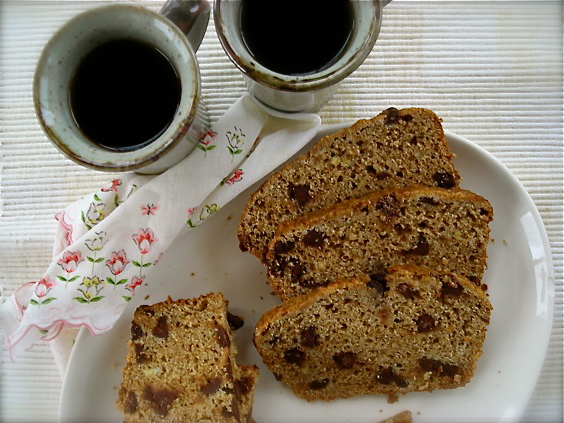
I never varied from that banana bread recipe I had. Whenever bananas in my first kitchen made it further than a bowl of cereal, or an afternoon snack smeared with peanut butter, I would do as Mom did, peel them down, mash them with a fork and make a loaf of banana bread. But, as I could now do as an adult, with my own hand mixer, a container for flour and sugar in my cupboard that was always full, with the familiar can of baking powder next to them, I would leave out those gross nuts. My banana bread was spartan. All it needed was banana. Sometimes a smear of soft butter would coat the slice, or maybe peanut butter went on the bread too. But I never needed a reason to stray from the recipe that I’d known all my life. It was banana bread perfection and it was Mom and it was all I needed. When she died, making a loaf of her banana bread was like evoking her memory in my kitchen, with my heart breaking again, through each press of a fork into the banana, turning the flesh to the proper level of mashed for the recipe. Then each bite of her bread would send my very adult mind reeling backwards into the kitchen of childhood, the sunny window, the deeply patterned blue carpet and my Mom, happily peeling spotty brown bananas, the old familiar bread pan on the counter next to her.
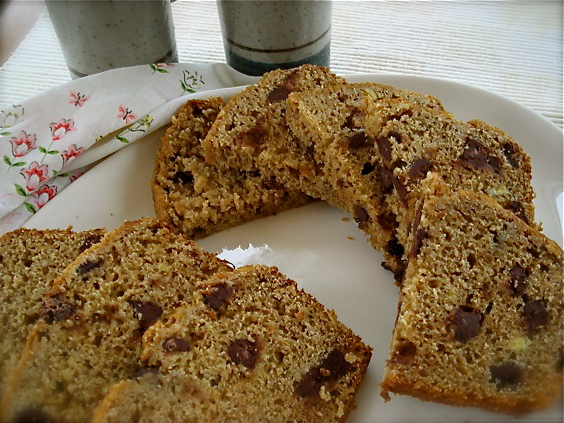
I’m not sure what happened the last time I made Mom’s Banana bread recipe, but the first bite put me off quite a bit. It tasted…. I don’t know, odd. Fake, I guess. I was really kind of shocked by the flavor. I’d grown up with this recipe; I’d made it dozens of times since I was a kid and here I was, by leaps and bounds an adult and quite the responsible one too, with a good job, a home and a child and yet, I looked at the slice of banana bread in my hand and it didn’t fit anywhere with the life that I’d found. It didn’t even bring Mom’s face to mind, her laughing smile and the way she would grab my shoulders and squeeze me just a little, making a delighted teeny squeak of her love for me. My mouth, my taste and my opinion had grown right alongside my life, and this recipe didn’t do it for me anymore. Part of me was crushed. It was the familiar flavor of a life that was now gone, and it was failing to bring to me the comfort I was seeking, comfort away from a world of bills, deadlines, a hectic job and single parenting. I didn’t get rid of the recipe because that might feel a little like experiencing Mom’s death all over again. But I haven’t made that particular version for a long, long time.
Ever since then, I’ve been on the lookout for the next best Banana Bread recipe. When the bananas in my house get past their prime, I simply place them in the freezer and wait it out. I search the wide range of recipes available for one that might take me home again, a feeling of nostalgia, of banana bread perfection, a slice that might elicit that memorable squeak of love I recall. At one point, I think I had 10 frozen bananas in there, and part of me mourns the loss of that constant. I have looked over dozens of recipes and rejected most of them; too much fat, too much oil, wayyyyyy too much sugar and in almost all of them, not enough Mom. So I keep searching, finding a few gems here and there to sample in my own sunny kitchen, with it’s warped old bread pans. And the bananas meanwhile, well, they tend to pile up in the freezer, silently waiting to succumb to a fork, a whisk and a hot oven to be baked into a memory that will sustain me through the years ahead.
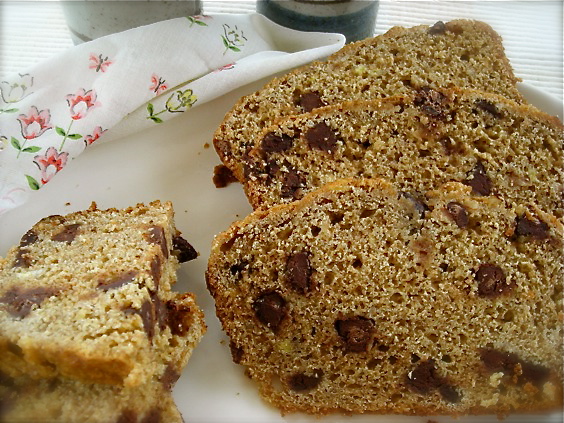
I’m still looking for that ultimate, that perfect banana bread, and I find that I’m really enjoying the experiments I’m coming across. This current one I’ve found is really quite good, in a clever and surprising way. What appeals to me about this particular recipe is that it includes crushed graham crackers crumbs in the base. This gives it a texture that’s a bit more crunchy than you would expect, and the taste of the graham crackers is really pronounced if you share the slice with a steaming cup of coffee. It’s perfect together, like banana and chocolate, like mothers and baking; with the familiarity of ritual, an old trusted bread pan and a freezer full of fruit at the ready.
Banana Chocolate Chip Bread
1-2/3 c. graham cracker crumbs (approx. one standard package from a box)
1-1/2 c. whole wheat flour
1/2 c. natural cane sugar (you can use regular granulated too)
1 T. baking powder
1/2 t. sea salt
3 medium bananas (i like to mash two of them fully, then leave the third in chunks for texture)
1/2 c. milk (any kind will do- I like vanilla soy, and almond would be wonderful)
3 T. canola oil (or get crazy and use olive oil- it tastes wonderful)
2 eggs, lightly beaten
6-oz semi-sweet chocolate chips
Preheat oven to 350°. Spray a standard 9×5 loaf pan with cooking spray.
Place graham cracker crumbs, flour, sugar, baking powder and salt in a bowl, and whisk well to combine.
In a large measuring cup, add bananas, oil, milk and eggs. Beat lightly with a fork to combine, then add to flour mixture. With a rubber spatula, carefully stir together until just blended with some streaks of flour remaining. Add in the chocolate chips and combine until mixture is fully incorporated. Scrape into prepared pan and bake for 50-60 minutes, or until top springs back when lightly touched and toothpick test comes out clean.
Allow to cool in pan for 30 minutes, then remove to wire rack to cool completely.
Need some other inspiration for banana baking? Try these:
Applesauce Banana Bread
Banana Poppyseed Bread
Peanut Butter Banana Bread
Whole Wheat Banana Pancakes
January 28th, 2011
| 10 Comments »
Sometimes all it takes for me to leap into a new recipe idea is something completely random that I either read or hear. It makes my culinary brain start spinning, usually because it’s a food item I’ve never heard of and have no clue as to what it is. I am nothing without my near obsessive need to understand all aspects of food, and when faced with this empty space in my food dictionary, I am unable to resist the urge to learn, to know more and to understand.
Take Horchata, for example. I’d never heard of it before seeing one brief mention of it from someone on Twitter, along with the question of how it could possibly create a stunning French Toast, and I basically leapt into researching it like I’d been shot from a rocket. Strange, I know, but my brain likes to evolve; I’m not content to rest on any kind of laurels with my quest to find out as much as I can about the cuisines of the world. Horchata, for those uninitiated, is a cool and refreshing drink, usually a type of aqua fresca, served traditionally with Mexican style meals. It’s light, creamy and easily pairs with most any foods, especially dishes with a lot of spice and heat. It’s not, however, made with milk so it’s a lovely dairy free beverage.
The standard Horchata recipe combines ground rice and almonds with water, lime juice and zest and cinnamon. This mixture is saturated with water and allowed to stand overnight, then it’s drained, resulting in a delicious liquid that you sweeten with either white or brown sugar. I wasn’t at all certain how it would taste, but my first sip dashed away any doubt; this was stellar, and here I was enjoying it zealously during some of the coldest days of our Minnesota winter. For a hot summer day, I would imagine this is a perfect accompaniment to a sultry afternoon, and I look forward to the day that I can test that theory. For now, I’ll settle with it being the base to the best tasting french toast that’s crossed my kitchen counters in a long, long time.

French toast is really not that interesting of a dish. There’s a creamy custard that you dip slices of bread into, which are then cooked on a hot skillet, doused with syrup, spread with jam or maybe sprinkled with powdered sugar. It’s simple and basic, and really, the bread you use can make or break the final result. But overall, there’s little you can do to make the dish leap from it’s ubiquitous nature to something altogether stunning. Unless you start with Horchata as your base.
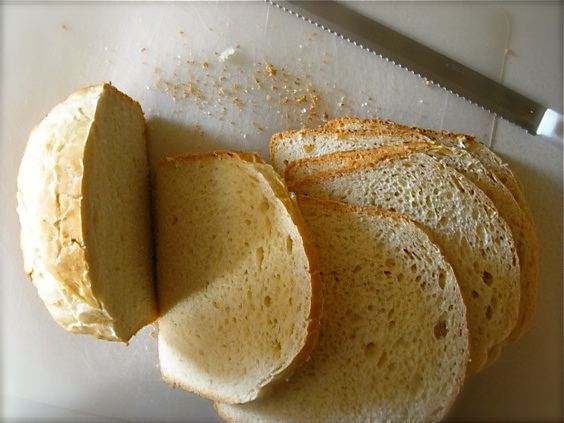
The Horchata, when made from scratch, only requires forethought to prepare. Most of the work is done as it sits on your counter, marrying the amazing flavors of almond, lime and cinnamon together. Strain it, sweeten it and chill it and you’ve got a pitcher of perfection whenever you need cool refreshment. I looked to the most trusted source for South of the border delights, the never fail Lisa of Homesick Texan, and sure enough, she had a recipe for Horchata that came straight from Rick Bayless. Between those two, there was no way this would disappoint.
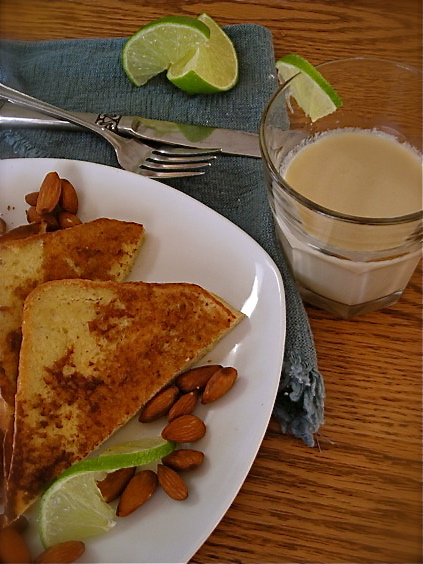
And it didn’t. Nutty from the almonds, zesty with lime and lush with light, refreshing flavor, the French Toast was a delight from first bite to last. It needed only a minimal drizzle of maple syrup to make it perfect. Make up a big batch if you can; the flavor sustains itself in your refrigerator, making it perfect to have on hand for a delicious and quick breakfast.
Horchata
Ingredients:
2/3 cup of uncooked rice
1 1/4 cups of blanched almonds
1 teaspoon of lime juice
Zest from one lime
1 cinnamon stick
1 teaspoon vanilla extract
1 cup of sugar or brown sugar, depending on how dark you want the drink
Method:
In a blender or spice grinder, grind the rice until it’s powdery. Place ground rice, almonds, lime juice, lime zest and the cinnamon stick in a pot and cover with two cups of warm water. Let stand overnight or for eight hours.
After the mixture has soaked, take out the cinnamon stick and pour contents into a blender with two cups of water and blend until smooth. Take a mesh colander that has been double lined with cheesecloth, and over a bowl or pitcher slowly pour the mixture, wringing the cheesecloth to get every last drop out. You should have a milky, smooth liquid at this point. If there are still rice and almond bits floating around, strain it again.
In a pot, heat up one cup of sugar and one cup of water on medium heat until the sugar has dissolved. Stir this sugar water into the horchata, along with the vanilla. Add one more cup of water and serve over ice or chilled. Mixture may separate under refrigeration. Just stir to combine.
(From Homesick Texan, and adapted from Rick Bayless)
Horchata French Toast
2 c. prepared Horchata
3 eggs
1 t. ground cinnamon
2 T. natural cane sugar or brown sugar
Whisk custard ingredients in large wide bowl. Heat skillet until a drop of water sizzles and vaporizes on impact. Dip bread into custard and cook until browned on one side; flip over and repeat.
November 28th, 2010
| 8 Comments »
This is the best kind of morning. It’s so quiet as I’m the only one awake. We decided last night to attend the late church service this morning, so instead of rolling everyone out of bed to get out of the house by 8:30, we’re not needing to be coherent until a few hours later. And when the cats started their pre-dawn routine of scratching at the bed to get someone up, I arose to greet the sunrise with them, affording my hard-working spouse yet another day of extended sleep. Five days a week he rises before the sun to delve into his work, to think and sip his coffee and deal with these cats that somehow think going outside on these dark, cold mornings is a really good idea. And apparently, it is for like 2 minutes, then they race back in for the nearest blanket and cozy fleece bed. The little turds.
But today is my day. And I’ve found an amazing sense of calm in these quiet hours. I can write, and think and plot and dream. I can surf, lurk and sip dark, rich coffee. I can hear myself think and often find some wonders brewing in my own head.
And I can nibble on these incredible Sweet Potato biscuits.
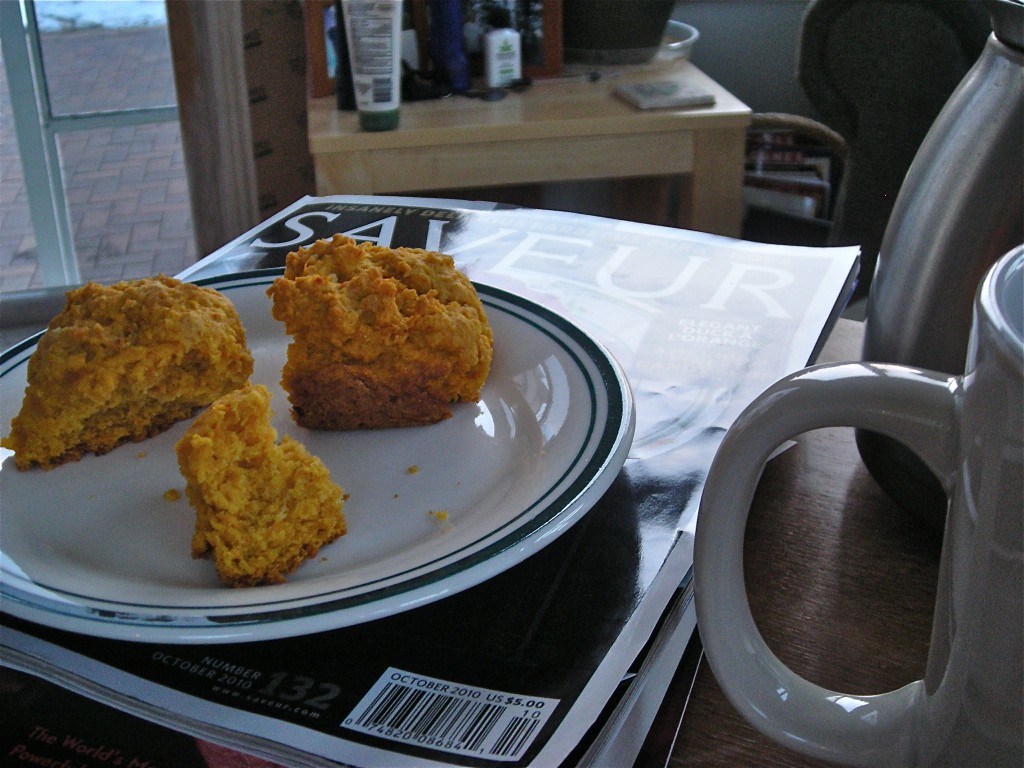
This is my morning; it’s me, the coffee pot, my big mug and a stack of inspiration. It’s the sunrise outside the windows, a fleece blanket on my lap and sometimes a cat. It’s peaceful. It’s contemplative. The birds flit around the feeders outside, gathering in the hawthorn tree while I watch and observe. The cardinal flashes his bright red feathers against the white of the snow. The bluejay squawks. The goldfinch chatter. The crows call from the rooftops and the sun turns the sky from winter’s deep blue to hints of azure and bronze. The sunrises lately have been lovely, even when so fleeting. I’m happy to be sitting here to appreciate them.
It’s my morning time. It’s perfect. And these biscuits? Well, you would do yourself a favor to have a pan of them at any meal, and then steal away one quiet morning with a mug of dark coffee and a few of them on a plate to fill your belly. The lovely hue of orange is one of their many appealing features, but the fluffy, moist and tender crumb that spills out when you crack one open is the best part about them. With a cat, or not; with a sunrise or a bowl of steaming soup, served with any meal they will compliment it highly. They will inspire. Like the sunrise and a quiet morning.
Sweet Potato Biscuits
from The Kitchen Sink Recipes (and from Bon Appetit)
Yield: 12 to 15 biscuits
One 3/4-pound red-skinned sweet potato (yam), peeled, cut into 1/2-inch cubes
1 3/4 cups all purpose flour
1 tablespoon (packed) dark brown sugar
2 1/2 teaspoons baking powder
1 teaspoon salt
1/2 teaspoon baking soda
Pinch of cayenne pepper
8 tablespoons (1 stick) chilled unsalted butter, cut into 1/2-inch cubes, plus 2 tablespoons butter, melted
1/3 cup chilled buttermilk
Cook sweet potato in medium saucepan of boiling salted water until tender, 8 to 10 minutes. Drain, cool, and mash.
Position rack in lower third of oven; preheat to 425°F. Butter bottom and sides of 8- or 9-inch cast iron skillet (or 8- or 9-inch cake pan).
Whisk flour and next 5 ingredients in large bowl. Add cubed butter to flour mixture; toss to coat and rub in with fingertips until mixture resembles coarse meal. Whisk 3/4 cup mashed sweet potatoes and buttermilk in medium bowl. Add to flour mixture; toss with fork. Gather mixture in bowl, kneading until dough comes together. Turn dough out onto floured work surface and pat into 1-inch-thick round. Using 2-inch round biscuit cutter, cut out biscuits, flouring cutter after each cut. Gather scraps; pat into 1-inch-thick round. Cut out additional biscuits, until the dough has been used.
Arrange biscuits side by side in prepared skillet or pan. Brush with melted butter. Bake until puffed and golden on top and tester inserted into center biscuit comes out clean, about 22 minutes. Cool 10 minutes in pan. Turn biscuits out and gently pull them apart.

Just a few days left of National Blog Posting Month!!!
November 27th, 2010
| 5 Comments »
It happens, right? There’s so much turkey, and celebrating and eating, then more eating and more celebrating and having another piece of pie before we drag full tummies home and into bed, falling exhausted against the pillows.
Then we open the fridge to see all that leftover turkey. That is, if you’re lucky enough to be gifted with leftovers.
I always make more than I think I even need. I’m fine with leftovers, in fact, I love having to re-purpose my food into something else. And this year, with a huge ziploc bag of turkey, I am chomping at the bit to make some awesome meals in the next few days. So, what’s in your plan for that meat? The leftover gravy? The stuffing? Extra potatoes?
These are some ideas for that extra bounty from our holiday.
The simplest of all meals would be to combine turkey, and any leftover gravy that you have and serve it over bread. or leftover mashed potatoes. Or both. Talk about comfort food. This is one of Griffin’s most favorite meals to eat, and I’m sure if I suggest this to him, he will roll his eyes in pleasure, nodding emphatically for me to put it together.
A good frittata is perfect for using up leftovers, and if there are leftover mashed potatoes, you can whip up an interesting version of it by whisking the potatoes and eggs together. This will create a fluffier version of frittata, or make it into a scramble by adding chopped turkey and a little bit of cranberry relish if you have it. Cranberries in eggs is surprisingly good, but just a little as it can easily overpower all other flavors.
Leftover mashed potatoes can be made into Potato Cakes. This rich and comforting food is a rare indulgence in our house, but perfect for those potatoes. Form the mashed potatoes into a cake and dredge it in seasoned flour. Heat a skillet, and melt some butter then place the cake in the skillet and let it sit until the bottom is superbly browned and crispy. Carefully flip it over and do the same to the other side. Be patient and keep the heat moderate, as you will be amply rewarded with a crusty and hot little side for your breakfast.
Will you make soup? That’s pretty standard, especially if you have a turkey carcass to use. I love a good soup, and we eat soup in the wintertime every week. My friend Missy has a wonderful recipe for Creamy Turkey Wild Rice soup on her blog. The photos make my mouth water. That’s the kind of soup that will make an appearance in my kitchen too, as there’s nothing better for a cold night than a warm and creamy, comforting pot of soup. One year I discovered just how good leftover gravy was in making soup. I started a pot of vegetables sizzling before I realized that I was out of soup stock base. I did have gravy, leftover in the freezer so I pulled out the container and chopped out just enough pieces, adding it to the pot with water. It made for a perfect soup.
A quick meal to throw together with leftover turkey could be Turkey Quesadillas. We like to keep tortillas on hand, as well as cheese so that a quick meal can be put on the table when the creativity flow has been stymied. Heat your tortilla in a pan then top with shredded cheese and chopped turkey. If you enjoy them, you could add canned beans too, like pinto or black beans. Top with another tortilla, and cook, turning once until tortillas are crispy and browned. Serve with salsa and sour cream.
A good option for lunch would be a turkey salad. I love Curried Chicken Salad, and substituting turkey is perfect. The recipe I include below calls for dried cherries, but subbing either dried cranberries, or even a scoop of extra cranberry relish would make this really delicious. Bonus points for utilization!
Another favorite salad option, one that would be perfect for lunches at work is this Turkey and Dried Cherry Pasta Salad. Again, sub in dried cranberries, or the fresh relish for a unique taste. And another good salad option, making a hearty dish that’s perfect for a meal or as a side is this Turkey & Wild Rice Curry Salad from Brenda, of A Farm Girl’s Dabbles. I saw her recipe and just about started drooling. I love salads like that; there’s just so much going on in one bowl. It’s a party for anyone’s tastes buds.
And naturally, a turkey sandwich is standard. Jazz it up by spreading your bread with cranberry relish first for a nice twist.
Curry Cashew Chicken Salad
From The Curry Book by Nancie McDermott
2 cups cooked chicken
1/2 c. dried cherries, cranberries or raisins
1/2 c. chopped roasted salted cashews
2 green onions, finely chopped
Dressing:
1/2 c. mayo or preferred creamy spread
2 T. mango chutney or fruit spread of choice
2 t. curry powder
2 t. red wine vinegar
1/4 t. fresh ground pepper
1 t. dijon mustard
Combine chicken, fruit, nuts and onion in bowl. Separately, mix together dressing ingredients and stir until combined and creamy. Pour over salad and stir thoroughly to coat. Chill. Eat.
Turkey & Dried Cherry Pasta Salad
1# pasta of choice
2 c. cooked turkey, chopped
1 c. dried cherries (sub cranberries, or even raisins)
1/2 c. minced red onion
1/2 c. minced celery
1/2 c. chopped toasted almonds
Dressing:
1/4 c. powdered sugar
2 T. white vinegar
1-1/2 c. mayonnaise
2 T. cold water
2 T. poppyseeds
Salt and Pepper to taste
Combine cooked pasta, turkey, dried fruit, onion, celery and almonds in a bowl. Whisk dressing ingredients together until smooth and pour over pasta mixture, tossing to coat. Serve topped with extra almonds, if desired.

November 19th, 2010
| 4 Comments »
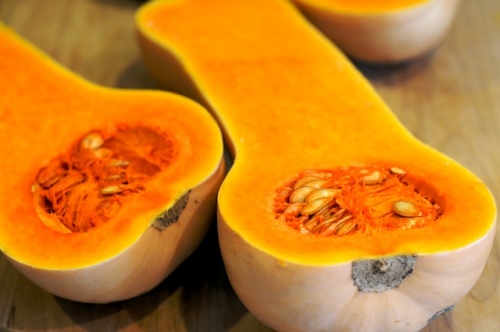
(photo from “That’s Yummy”)
We’re woefully into November’s gray and flat winter light. The cloud cover expanse across the sky is leaden and heavy and daylight begins to fade around 4:00pm, yet even in the best of midday light, the ability to take a good photo often is a crapshoot. I don’t really mind the changes that come around this time of year, this first adventure into winter, the shorter days and descent into wool sweaters, layers, warm socks and extra blankets on the bed. The coziness of it is good, it’s necessary, and there’s a lot of it that can be so soothing- like the leaping blue flame under the daily tea-kettle, the ritual of a warm steaming cup to carry me through the late afternoon; there’s the presence of the strands of tiny twinkling lights we’ve used to adorn certain areas of our home- the stairwell for those dark, dark mornings, the top of the cupboard in the kitchen, and the fancy festooned bakers rack in the corner of our kitchen.

The tiny lights are nice in those early mornings before the dawn when Mike is awake; it provides enough light to get the coffee pot going and the cat dishes filled without having that eye-burning glare that we encounter when first out of bed. The stairwell lights guide him safely down in the darkness. We put these lights up many years ago at Christmas time, and they’ve proven to be so useful that we never removed them. In those gloomy November afternoons they add a warm touch to our home, along with the singing tea kettle, and those steaming cups. Add a candle or two and you can chase those dark hours away a lot easier.
A good warm oven and simmering pot on the stove does that too. I recently came across a recipe for Butternut Squash Pasta, in Gourmet magazine’s Best of 65 Years cookbook. It was a simple process of cooking cubed squash then tossing it with garlic and pasta, but I thought to take it one step further and create an awesome squash puree to mix in with pasta, creating a saucy topping that clung to every single bite.
Problem was, as delicious as it tasted, it looked just ghastly. Imagine, brightly colored orange squash mixed with cooked whole wheat pasta. Oh gads…. it was homely as all get out, but tasted glorious and superbly like comfort in my bowl. I do recommend it, even if I can’t show you the result. Roast your halved butternut squash until it’s good and soft. Scrape the flesh into a bowl, add a little broth or milk to help thin it, then mash it smooth. You can whiz it in the food processor too. The resulting puree should be thick, close to the texture of canned pumpkin, and can be used like canned pumpkin, which, after all, is squash right?
Having the use of pureed squash on hand made it a cinch to whip up a batch of muffins too, and after finding a recipe for Whole Wheat Muffins with Pumpkin and Quinoa on Fork, Knife and Spoon, I knew those had to somehow come out of my oven in the near future. With a little trip towards the healthy side of muffins, these little beauties came out bouncy soft, only the slightest bite of sweet and full of chewy nibs of quinoa blended with the sweet taste of roasted squash.

Touched inside and out with toasted coconut, they had a lot going for them. A bite for breakfast, a quick pick me up snack or a nice late night treat before climbing under piles of blankets, they fill in all parts of your day with a compliment for your tummy. Follow the link to Kate’s blog ( I know! Another Kate! ) for the original recipe. I doctored mine up to utilize what I had on hand for my version.
Whole Wheat Muffins with Quinoa and Squash
2 c. whole wheat flour
1-1/2 c. cooked quinoa
1/2 c. pure maple syrup
2 t. baking powder
1 t. baking soda
1 t. ground cinnamon
1/2 t. ground nutmeg
1/4 t. ground allspice
1/2 t. sea salt
1 c. cooked butternut squash
1 egg
3/4 c. buttermilk
3 T. oil
1 t. vanilla extract
1/2 c. shredded coconut, toasted
Preheat oven to 375 and spray muffin pans, or line with paper. You will get approximately 18 muffins.
To cook quinoa- measure one cup of water in a saucepan and place over medium burner. Rinse 1/2 cup of quinoa in a wire strainer under cold running water, shaking to rinse thoroughly. Place quinoa in saucepan and bring to a boil. Reduce heat, cover and simmer about 10-15 minutes until all the water is absorbed. Remove pan from heat and let stand for 10 minutes, then scrape cooked quinoa onto a plate and spread out to cool.
When cooled, measure flour and quinoa into a large bowl. With your hands, gently toss together until blended, and quinoa appears the size of tapioca pearls. Add in baking powder, soda, spices and salt and mix thoroughly.
In another bowl, measure buttermilk, then whisk in syrup, egg, squash, oil and vanilla. Whisk together, then add to dry ingredients with coconut. Using a rubber spatula, gently fold ingredients together until incorporated. Do not overmix. Scoop into muffin tins, about 2/3 full and bake for 15-18 minutes, or until tops are browned and spring back when touched. Allow to cool in muffin pans for 15 minutes or so, then turn out onto wire racks to cool completely.

And without even realizing it, I’m more than halfway through NaBloPoMo, or National Blog Posting Month. It’s proven to be way easier than I anticipated, but with 4-1/2 years of archives to wander through and re-introduce, I’m never at a loss for material.
|























